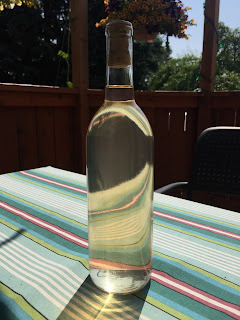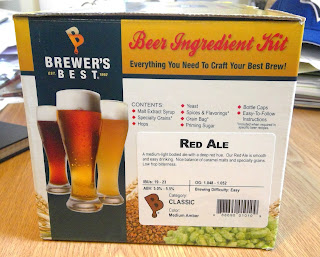 |
Portable Refractometer. The item came with a case, an eyedropper, a small
screwdriver (for the calibration screw), instructions, and a cleaning cloth.
|
A refractometer measures the index of refraction of a medium. The index of refraction, n, is the ratio of the speed of light in a vacuum compared to the speed of light in the medium of interest. For example, n for water is 1.333, which means that light travels 1.333 times slower in water than in a vacuum. Refraction is when light "bends" on entering a medium with a different n. When I described this to my daughter, she immediately gave the example of looking at a plastic straw in a glass of water - it looks like it's bent.
The key thing to know is that sugar solutions have a larger n than water. And, if you increase the sugar concentration, n increases. This can be calibrated and you can use a relatively simple optical measurement to determine sugar concentration, as opposed to measuring specific gravity with a hydrometer.
Personally, I find the measurement of specific gravity with a hydrometer to be a chore. For one, you need to sanitize the hydrometer and the cylinder or wine thief used to hold the liquid during the measurement. So, every time you want to measure s.g., you need to sanitize stuff. Second, hydrometers are made of glass, so they are fragile and it's no fun if you break one by accident. Third, s.g. measurements are a bit imprecise due to the size of the meniscus relative to the calibration marks on the hydrometer. And, if there are bubbles stuck to the hydrometer, the s.g. reading will be higher than it should. You need to measure s.g. two or three times to make sure the reading is consistent.
Measuring Brix with a refractometer is just simple. All you do is place a few drops (yes, DROPS) of liquid on the prism, close the "daylight plate", and look through the eyepiece for the reading. In this particular refractometer, the dual scale is given in Brix and "Approximate % of Alcohol". The images below show what you see in the eyepiece.
 |
Refractometer Brix scale with water on the prism.
(Photo obtained by placing the eyepiece up to the camera on a MS Surface tablet)
|
 |
| Refractometer Brix scale with freshly pressed apple juice (for cider, of course!) |
The one big limitation of measuring the index of refraction is that it's only really useful for measuring sugar content before fermentation starts. When fermentation starts, the sugar concentration decreases, and alcohol increases. Alcohol, just like sugar, increases the index of refraction. That means that the n measurement is no longer proportional to sugar concentration. Rather, n is affected by sugar and alcohol concentrations. Apparently there are online calculators that allow you to calculate sugar and alcohol concentrations from a mid-fermentation refractometer reading, so long as you know the starting Brix. This sounds fine in theory, but I have a bias against "black box" calculations like that. Even though it's a chore, you are probably going to get a more reliable measure of fermentation progress from a direct measurement of s.g. with a hydrometer. Give me the choice, and I would rather have a direct measurement than a value from a black box. That being said, it would be interesting to compare s.g. measurements with corrected refractometer readings using an online calculators.
From a quick survey of YouTube videos on refractometers, it seems that a number of home brewers like to use refractometers when they are making up their wort, and then they use hydrometers once fermentation is under way. This makes a lot of sense.
Christmas Cider
1.5 gallons freshly pressed apple juice
1/2 tsp peptic enzyme
2 tsp yeast energizer
3 crushed Campden tablets
1.5 gallons water
approx. 3 cups granulated sugar
1 packet of champagne yeast (Lalvin EC-1118)
1 tsp. nutmeg
5 cinnamon sticks
3/4 cup dextrose (priming sugar)
Instructions*:
Add peptic enzyme, yeast energizer, and Campden tablets to the apple juice and let it sit in the closed primary fermentation bucket for 24 hours. Then, add water and stir thoroughly. Add sugar in 1 cup increments, stirring thoroughly after each addition, and measure Brix with a refractometer until Brix = 9. (If measuring s.g. with a hydrometer, aim for s.g. = 1.035 - 1.040.) Sprinkle yeast on surface of the juice and close the lid loosely on the primary (you can also use a primary with airlock). When the foam collapses, siphon the cider into a sanitized 3 gallon carboy for secondary fermentation. At this point, add the nutmeg and cinnamon sticks. Seal the carboy with an airlock. When fermentation is complete, siphon the cider into bucket and mix in the dextrose (1/4 cup per gallon of cider). Bottle in beer bottles and seal with bottle caps.
*Note: This is a customized version of the apple cider recipe in the Winemaker's Recipe Handbook, known as the purple booklet









